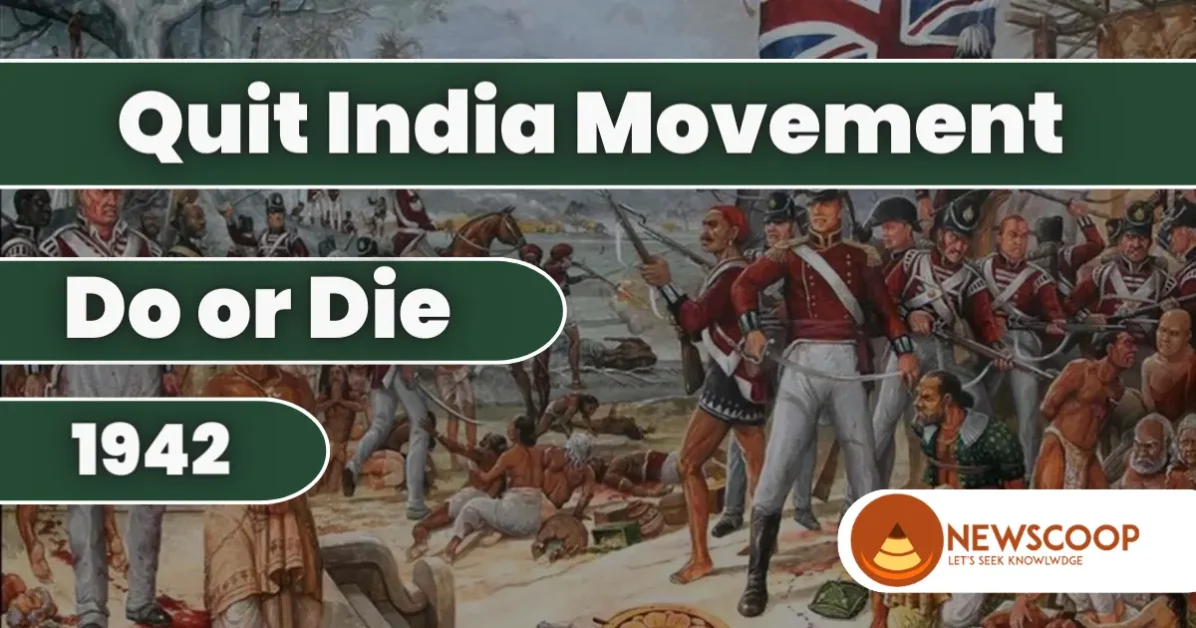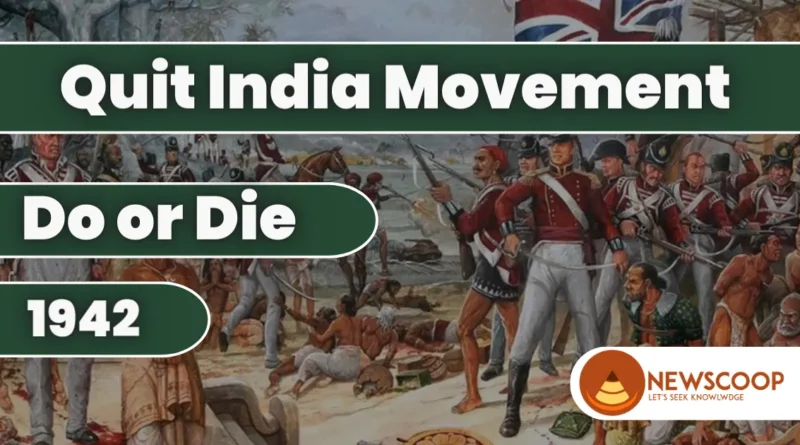Quit India Movement: History, Causes & Facts | UPSC
If you are searching for the “Quit India Movement for UPSC“, you have come to the right place. In this article, we will discuss the decisive stage of the Indian National Struggle. This phase was started in 1940, where on one side different missions and plans were announced by the British Governor, on the other hand, the battle of Do or Die began between India and the British.
The Quit India Movement was a mass nonviolent resistance movement against British rule in India that took place in 1942. The movement was led by Mahatma Gandhi and the Indian National Congress, with the objective of demanding an immediate end to British rule.
The British government responded with a harsh crackdown, but the movement served as a significant turning point in India’s independence struggle, demonstrating the determination and resilience of the Indian people and putting pressure on the British government to consider transferring power to Indians.
| Start Date | 8 August 1942 |
| Congress Session | Bombay Session |
| Starts From | Gawalia Tank, Bombay |
| Ended in | 1944 |
| Started by | Mahatma Gandhi and Indian National Congress |
| Objective | To demand an immediate end to British rule |
| Causes | August Offer, Cripps Mission |
History & Background
- The 2nd World War was started on September 1, 1939, and two days later the British Government of India declared India’s support for the war without consulting Indian opinion.
- Congress was totally against Fascist forces and sought to support Allied forces. But he believes that India cannot fight for the freedom of another country while being in slavery.
- The official congress position was adopted at the Wardha session of the Congress working committee, and different views of congress leaders come to the fore.
- Gandhiji made a clear distinction between the democratic nation of Western Europe and the totalitarian Nazis & Fascists.
- Subhas Chandra Bose and other socialists argued that the was being fought by imperialists on both sides. So, neither side should be supported by the nationalists.
- They taught, it was the ideal time to launch a movement, to take advantage of the situation and snatch freedom from Britain.
- Jawaharlal Nehru had a different stand among all these, he said that before India gets freedom, neither India should join the war nor start any movement by taking advantage of Britain’s difficulties.
- Finally, Nehru ji’s stand is declared as India’s official stand.
- The CWC Resolution condemned Fascist aggression but said that India could not be a party to a war being fought, for democratic freedom, while that freedom was being denied to India.
- British Government’s response was entirely negative. Viceroy Linlithgow made a statement on 17th October 1939, trying to use the Muslim League and the princes against the congress.
Also Read: Revolt of 1857
Causes of the Quit India Movement
1. August Offer, 1940
In 1940, Hitler’s astounding success and the fall of Belgium, Holland, and France put England in a conciliatory Mood. Further, Congress was also ready to compromise with the British if they were allowed to form an interim government. But, the British government didn’t accept the demand of Congress. But the government came up with its own offer called as “August Offer” to get the cooperation of India in the war effort.
- Linlithgow announced in August Offer that Dominion Status is the Objective for India.
- Proposal to expand the Viceroy’s Executive Council, which would have a majority of Indians.
- Agreed to set up a Constituent Assembly after the war, but also preconditioned that no future constitution be adopted without the consent of minorities.
Congress rejected the August offer because Congress want complete independence. Nehru said, “Dominion status concept is dead as a Doornail.” So in the late 1940s, the Congress once again asked Gandhiji to take charge. Further, Gandhi decided to initiate an Individual Satyagraha on an individual basis by a few selected individuals in every locality.
2. Individual Satyagraha, 1940
- The aim of Individual Satyagraha was to express the feeling of people that they are not interested in war, for them, there is no difference between Nazism and the double autocracy ruling in India.
- Further, It was also launched to give another opportunity for the government to accept Congress’s demands peacefully.
- The demand of the satyagraha would be the freedom of speech against the war through an anti-war declaration.
- If the government does not arrest them, then they will repeat these speeches from place to place and march to Delhi.
- Thus starting the movement which is also known as “Delhi Chalo Andolan” or “Vyaktigat Satyagraha“.
- Vinoba Bhave was the first Satyagrahi of Individual Satyagraha and Jawaharlal Nehru was the second Satyagrahi.
- By May 1941, 25000 people had been convicted for the Individual Civil Disobedience Movement.
Although the British Government was not ready to accept the demand of the Congress, soon such an international situation arises that they had to send another mission to India, which is called the “Cripps Mission“.
3. Cripps Mission, 1942
A mission headed by Stafford Cripps was sent to India with constitutional provisions to seek Indian support for the war in March 1942. But the proposal of Cripps also disappoints the Indian leaders.
- Key points:
- It proposed an Indian Union with a Dominion status and conveyed a constituent assembly to frame a new constitution.
- Further, members of this assembly would be partially elected by the provincial assemblies and partially nominated by the princes.
- It was also proposed that, if any province was not willing to join the union could have a separate constitution and form a separate Union.
- Failure:
- The Congress objected to the offer of Dominion status instead of a provision for complete Independence and representation of the princely state by Nominees.
- Thus, Cripps Mission failed and turned out to be merely a propaganda device for the consumption of the US and the Chinese.
Indian leaders understand that there is no benefit to negotiation with the Britishers, and there is a need for a massive mass movement which emerged as the “Quit India Movement“.
Quit India Movement

Important Facts:
- Resolution for Quit India Movement:
- After Cripps’s mission, Gandhiji framed a resolution calling for British withdrawal and a non-violent non-cooperation movement against any Japanese invasion.
- On 14th July 1942, the idea of this resolution was accepted in Wardha Session.
- On 8th August 1942, The Quit India Resolution was ratified at the Congress meeting at Gwalior Tank, Bombay.
- Gandhiji gave the slogan “Do or Die” in this meeting itself.
- British Response:
- The British Government was neither in the mood for any negotiation nor wanted to wait for the start of the Quit India movement.
- In the early hours of august 9 1942, in a single sweep, all the top leaders of Congress were arrested and taken to unknown destinations.
- Further, all the Congress organizations were declared illegal.
- Immediate Public Reaction:
- A sudden attack by the government evokes an instant reaction among the people.
- As the news of the arrest spreads, lakhs of people gather at Mumbai’s Gwalior tank and clashes with the authorities begin.
- Similar disturbances were also seen in Ahmedabad and Pune on 9 August 1942.
- Strikes, Public demonstrations, and profession type of activities were most intensive in many areas of Delhi, UP, and Bihar.
- Meanwhile, many leaders of Congress escape from arrest and they go to their respective areas to start preparing for resistance organizations.
- The news of the movement(Bharat Chhodo Andolan) starts reaching every village and its effect was seen all over the country.
Features of the Quit India Movement
- Public Response:
- The general public attacked symbols of authority and hoisted National flags forcibly on public buildings.
- Satyagrahis offered themselves up to arrest, Bridges were blown up, Railway tracks were removed and, telegraph lines were cut.
- Students strike schools all over the country and start distributing Illegal magazines.
- Although martial law was not applied, the repression was severe.
- Rebellious villages were fined heavily, and in many villages, mass flogging was done.
- By the end of 1942, more than 6000 people were arrested by British officials.
- Due to this brutal repression, the phase of the struggle was eliminated between 6 to 7 weeks.
- Underground Activities:
- Due to government repression, many nationalists went underground and continue their activities from there.
- Ramanand Lohia, Jayaprakash Narayan, Aruna Asaf Ali, Usha Mehta, Biju Patnaik, Chhotubhai Puranik, Sucheta Kriplani, and RP Goenka, etc were the main leaders who took up underground activities.
- Usha Mehta operates a radio in Bombay, It is used to maintain the morale of the people.
- Parallel Government:
- Along with this, the significant feature of the Movement was the establishment of the parallel government.
- The first parallel government was set up on August 1942 at Baliya(UP) under the leadership of Chittu Pandya.
- In December 1942, Jatia Sarkar came into existence at Tamluk.
- In mid-1943, Prati Sarkar was organized at Satara, Maharashtra. Further, Nana Patil & YB Chavan was leading Prati Sarkar.
- Mass Movement:
- This was a Mass movement, as people all over the country contributed in different ways to this movement.
- Youth, especially the students of schools and colleges remained at the forefront.
- Women and workers also participated in very large numbers.
- Muslim participation was witnessed, they helped by giving shelter to underground activists.
- The communist did not join the movement, in the wake of Russia being attacked by Nazi Germany. But they also supported Quit India Movement on a personal level.
Conclusion
It was proved by Quit India Movement that Indians could not be kept far away from independence. In this way, every section of society participates in this movement and the moment establish the truth that it was no longer possible to rule India without the wishes of India. Further, The British understood that if such a movement happened again, it would not be possible to repress the Indians.
So, this was all about Quit India Movement. If you like this article, please share it with your friends.
Thank You!
Why did Gandhiji start the Quit India Movement?
Gandhi ji wanted to free India from the chains of the British, and he did that work well and led a mass movement towards independence.
Who gave the slogan of the Quit India Movement?
Mahatma Gandhi gave the slogan “Do or Die“. This means the determination of the Indians was now clear that either they will take independence or accept death.
What was the other name of Quit India?
“Bharat Chhodo Andolan” was another name for Quit India Movement.
What was the main objective of the Quit India Movement?
The main objective of the Quit India Movement was to demand an immediate end to British rule in India.
What was the response of the British government to the Quit India Movement?
The British government responded to the Quit India Movement with a harsh crackdown, arresting the entire Congress leadership and declaring the movement as seditious. British forces used brutal force to suppress the protests, leading to widespread violence and loss of life.
Related Links:

